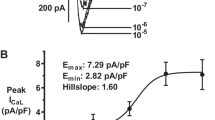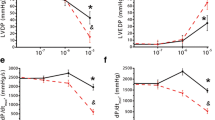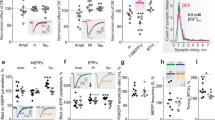Summary
We have previously shown that endogenous adenosine inhibits non-adrenergic, non-cholinergic (NANC) neurotransmission in isolated guinea-pig atria. In the present study the effect of adenosine analogues, such as N6cyclopentyladenosine (CPA), 5′ N-ethylcarboxamide adenosine (NECA), 2 chloroadenosine (2-CADO), R- and S-phenylisopropyladenosine (R- and S-PIA) on the cardiac response to transmural nerve stimulation has been tested in order to characterize the subtype of adenosine receptor involved in the inhibitory control of NANC neurotransmission. The effect of the adenosine antagonist 8-phenyltheophylline (8-PT) was then tested against CPA and NECA.
The prototypical A-1 selective agonist CPA was the most active agonist, reducing the response to the stimulation of NANC nerves with an IC50 value of 2.8 nM; RPIA, NECA and 2-CADO showed IC50 values of 9.5, 13.7 and 35 nM respectively. S-PIA was the least active agonist, showing an IC50 value (306 nM) about 30-fold greater than that of R-PIA (9.5 nM). None of the agonists tested was able to modify cardiac response to exogenous CGRR Furthermore, 8-PT competitively antagonized the effect of CPA and NECA with very close pA2 values (6.77±0.01 and 6.63±0.08 respectively). From these findings we concluded that prejunctional inhibitory adenosine receptors on capsaicin sensitive sensory nerves of cardiac tissue belong to the A-1 subtype.
Similar content being viewed by others
References
Arunlakshana O, Schild HU (1959) Some quantitative uses of drug antagonists. Br J Pharmacol 14:48–58
Belardinelli L, Isenberg G (1983) Isolated atrial myocytes: adenosine and acetylcholine increase potassium conductance. Am J Physiol 244:H734-H737
Böhm M, Bruckner R, Hackbarth I, Haubitz B, Linhart R, Meyer W Schmidt B, Schmitz W Scholz H (1985) Adenosine inhibition of catecholamine-induced increase in force of contraction in guinea-pig atrial and ventricular heart preparations. Evidence against a cyclic AMP- and cyclic GMP-dependent effect. J Pharmacol Exp Ther 230:483–492
Böhm M, Bruckner R, Neumann J, Schmitz W, Scholz H, Starbatty J (1986) Role of guanine nucleotide-binding protein in the regulation by adenosine of cardiac potassium conductance and force of contraction. Evaluation with pertussis toxin. Naunyn-Schmiedeberg's Arch Pharmacol 332:403–405
Böhm M, Pieske B, Ungerer M, Erdmann E (1989) Characterization of A1 adenosine receptors in atrial and ventricular myocardium from diseased human hearts. Circ Res 65:1201–1211
Brown CM, Collis MG (1983) Adenosine A1 receptor mediated inhibition of nerve stimulation-induced contractions of the rabbit portal vein. Eur J Pharmacol 93:277–282
Brückner R, Fenner A, Meyer W, Nobis T, Schmitz W, Scholtz H (1985) Cardiac effects of adenosine and adenosine analogs in guinea-pig atrial and ventricular preparation: evidence against a role of cyclic AMP and cyclic GMP. J Pharmacol Exp Ther 234:766–774
Bruns RF, Daly JW, Snyder SH (1983) Adenosine receptor binding: structure activity analysis generates extremely potent xanthine antagonists. Proc Natl Acad Sci USA 50:2077–2080
Burnstock G, Buckley NJ (1985) The classification of receptors for adenosine and adenine nucleotides. In: Paton DM (ed) Methods in pharmacology, vol 6. Plenum Publishing Corporation, London, pp 193–212
Chiba T, Yamaguchi A, Yamatani T, Nakamura A, Morishita T, Inui T, Fukase M, Noda T, Fujita T (1989) Calcitonin gene-related peptide receptor antagonist human CGRP-(8–37). Am J Physiol 256:E331-E335
Collis MG (1983) Evidence for A1-adenosine receptor in the guinea-pig atrium. Br J Pharmacol 78:207–212
Evans DB, Schenden JA, Bristol JA (1982) Adenosine receptors mediating cardiac depression. Life Sci 31:2425–2442
Fredholm BB, Hedqvist P (1980) Modulation of neurotransmission by purine nucleotides and nucleosides. Biochem Pharmacol 29:1633–43
Fredholm BB, Gustafsson LE, Hedgvist P, Sollevi A (1983) Adenosine in the regulation of neurotransmitter release in the peripheral nervous system. In: Berne RM, Rall RW Rubio R (eds) Regulatory function of adenosine. Martinus/Nijhoff, Boston, pp 479–495
Giuliani S, Amman R, Papini AM, Maggi CA, Meli A (1989a) Modulatory action of galanin on responses due to antidromic activation of peripheral terminals of capsaicin-sensitive sensory nerves. Eur J Pharmacol 163:91–96
Giuliani S, Maggi CA, Meli A (1989b) Prejunctional modulatory action of neuropeptide Y on peripheral terminals of capsaicin-sensitive sensory nerves. Br J Pharmacol 98:407–412
Gustafsson LE, Wiklund NP (1988) Adenosine-modulation of cholinergic and non-adrenergic non-cholinergic neurotransmission in the rabbit iris sphincter. Br J Pharmacol 88:197–204
Ishikawa T, Okamura N, Saito A, Masaki T, Goto K (1988) Positive inotropic effect of calcitonin gene-related peptide (CGRP) mediated by cyclic AMP in guinea pig heart. Circ Res 63:726–734
Kamikawa Y, Shimo Y (1989) Adenosine selectively inhibits noncholinergic transmission in guinea pig bronchi. J Appl Physiol 66:2084–2091
Kennedy C (1990) P1- and P2-purinoceptor subtypes — an update. Arch Int Pharmacodyn 303:30–50
Lokhandwala MF (1979) Inhibition of cardiac sympathetic neurotransmission by adenosine. Eur J Pharmacol 60:353–357
Londos C, Cooper DMF, Wolff J (1980) Subclasses of external adenosine receptors. Proc Natl Acad Sci USA 77:2551–2554
Maggi CA, Chiba T, Giuliani S (1991) Human α-calcitonin gene-related peptide-(8–37) as an antagonist of exogenous and endogenous calcitonin gene-related peptide. Eur J Pharmacol 192:85–88
Mantelli L, Amerini S, Ledda F (1989) Effects of opioid drugs on capsaicin-sensitive neurones in guinea-pig atria. Eur J Pharmacol 170:217–223
Mantelli L, Amerini S, Ledda F (1990a) Opioid agonists, prostaglandin E1 and clonidine modulate non-adrenergic, non-cholinergic transmission in the mammalian heart. J Auton Nerv Syst 30:5113–5116
Mantelli L, Amerini S, Rubino A, Ledda F (1990b) Characterization of opioid receptors modulating the function of capsaicin-sensitive neurons in guinea-pig atria. Eur J Pharmacol 180:325–330
Miyauchi T, Ishikawa T, Sugishita Y, Saito A, Goto K (1987) Effects of capsaicin on nonadrenergic noncholinergic nerves in the guinea pig atria: role of calcitonin gene-related peptide as cardiac neurotransmitter. J Cardiovasc Pharmacol 10:675–682
Paton DM (1981) Structure-activity relation for presynaptic inhibition of noradrenergic and cholinergic transmission by adenosine: evidence for action on A1 receptors. J Anton. Pharmacol 1:287–290
Richardt G, Waas W Kranzhofer R, Cheng B, Loshe MJ, Schoming A (1989) Interaction between the release of adenosine and noradrenaline during sympathetic stimulation: a feed-back mechanism in rat heart. J Mol Cell Cardiol 21:269–277
Rockoff JB, Dobson JG Jr (1980) Inhibition by adenosine of catecholamine-induced increase in rat atrial contractility. Am J Physiol 239:H365-H370
Rubino A, Mantelli L, Amerini S, Ledda F (1990) Adenosine modulation of non-adrenergic non-cholinergic neurotransmission in isolated guinea-pig atria. Naunyn-Schmiedeberg's Arch Pharmacol 342:520–522
Saito A, Ishikawa T, Masaki T, Kimura S, Goto K (1986) Pharmacological analysis of autonomic innervation of the right atria of rats and guinea-pigs: demonstration of nonadrenergic noncholinergic nerves. J Pharmacol Exp Ther 238:713–716
Saito A, Ishikawa T, Kimura S, Goto K (1987) Role of calcitonin generelated peptide as cardiotonic neurotransmitter in guinea-pig left atria. J Pharmacol Exp Ther 243:731–736
Schwabe U (1981) Direct binding studies of adenosine receptors. Trends Pharmacol Sci 2:299–303
Silinsky EM (1986) Inhibition of transmitter release by adenosine: are Ca2+ currents depressed or are the intracellular effects of Ca 2+ impaired? Trends Pharmacol Sci 7:180–185
Snyder SH (1985) Adenosine as a neuromodulator. Ann Rev Neurosci 8:103–124
Stone TW (1983) Purine receptors in the rat anococcygeous muscle. J Physiol (Lond) 335:591–608
Tallarida RJ, Murray RB (1981) Manual of pharmacological calculation with computer programs. Springer, New York Berlin Heidelberg
Tawfik-Schlieper H, Klotz K-N, Kreye VAW, Schwabe U (1989) Characterization of the K+-channel-coupled adenosine receptor in guineapig atria. Naunyn-Schmiedeberg's Arch Pharmacol 340:684–688
Van Calker D, Muller M, Hamprecht B (1978) Adenosine inhibits the accumulation of cyclic AMP in cultured brain cells. Nature (Lond) 276:839–841
Vizi ES, Knoll J (1976) The inhibitory effect of adenosine and related nucleotides on the release of acetylcholine. Neuroscience 1:391–398
Wakade AR, Wakade TD (1978) Inhibition of noradrenaline release by adenosine. J Physiol (Lond) 282:35–49
Wang X, Fiscus RR (1989) Calcitonin gene-related peptide increases cAMP, tension, and rate in rat atria. Am J Physiol 256:R421-R428
Williams M (1987) Purine receptors in mammalian tissues: pharmacology and functional significance. Ann Rev Pharmacol Toxicol 27:315–345
Williams M, Braunwalder A, Erickson TJ (1986) Evaluation of the binding of the A-1 selective adenosine radioligand, cyclopentyladenosine (CPA), to rat brain tissue. Naunyn-Schmiedeberg's Arch Pharmacol 332:179–183
Author information
Authors and Affiliations
Additional information
Send offprint requests to A. Rubino at the above address
Rights and permissions
About this article
Cite this article
Rubino, A., Amerini, S., Mantelli, L. et al. Adenosine receptors involved in the inhibitory control of non-adrenergic non-cholinergic neurotransmission in guinea-pig atria belong to the A1 subtype. Naunyn-Schmiedeberg's Arch Pharmacol 344, 464–470 (1991). https://doi.org/10.1007/BF00172587
Received:
Accepted:
Issue Date:
DOI: https://doi.org/10.1007/BF00172587




